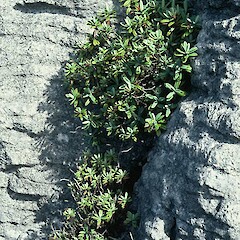Veronica scopulorum
Synonyms
Hebe scopulorum Bayly, de Lange et Garn.-Jones
Family
Plantaginaceae
Flora category
Vascular – Native
Endemic taxon
Yes
Endemic genus
No
Endemic family
No
Structural class
Trees & Shrubs - Dicotyledons
Chromosome number
2n = 40
Current conservation status
The conservation status of all known New Zealand vascular plant taxa at the rank of species and below were reassessed in 2017 using the New Zealand Threat Classification System (NZTCS) – more information about this can be found on the NZTCS website. This report includes a statistical summary and brief notes on changes since 2012 and replaces all previous NZTCS lists for vascular plants.
Please note, threat classifications are often suggested by authors when publications fall between NZTCS assessment periods – an interim threat classification status has not been assessed by the NZTCS panel.
- Conservation status of New Zealand indigenous vascular plants, 2017 . 2018. Peter J. de Lange, Jeremy R. Rolfe, John W. Barkla, Shannel P. Courtney, Paul D. Champion, Leon R. Perrie, Sarah M. Beadel, Kerry A. Ford, Ilse Breitwieser, Ines Schönberger, Rowan Hindmarsh-Walls, Peter B. Heenan and Kate Ladley. Department of Conservation. Source: NZTCS and licensed by DOC for reuse under the Creative Commons Attribution 4.0 International licence.
2017 | At Risk – Declining | Qualifiers: DP, RR
Previous conservation statuses
2012 | At Risk – Naturally Uncommon | Qualifiers: CD, PD, RR
2009 | At Risk – Naturally Uncommon | Qualifiers: CD
2004 | Threatened – Nationally Vulnerable
Brief description
Low growing sparse shrub bearing pairs of oval blueish-green leaves inhabiting limestone rocks near Kawhia. Leaves m-shaped in cross section, to 55 mm long by 16 mm wide, with a blunt tip. Leaf bud with small gap between base of leaves and hollowed between ridges in cross section.
Distribution
Endemic. New Zealand: North Island (western Waikato, south of Kawhia Harbour where it confined to limestone outcrops at the head waters of the Awaroa River and northern Taumatatotara Range).
Habitat
Confined to exposed limestone bluffs and rock outcrops.
Detailed description
Compact shrub 0.4–0.8 × 0.4–0.8 m. Mature stems black or grey, encased in thick cork; young stems green to brown; leaf scars evident; indument pubescent and bifarious to uniform. Leaf bud as long as mature leaves; sinus evident, narrowly acute to broad. Petiole 2–8 mm. Leaves erecto-patent to patent; lamina linear-elliptic, elliptic to narrowly oblanceolate, subcoriaceous, m-shaped in cross section, 14–80 × 4–16 mm, apex plicate, subacute to acute; base cuneate; upper surface green to dark grebe, glossy, under sides glaucous, dull. Inflorescences 7–40-flowered, 1–5 mm long, lateral, compound, racemose with 1–2 branches at base. Flowers hermaphrodite, pale mauve at anthesis. Calyx 2.3–3.5 mm, 4-lobed; lobes lanceolate, ovate or elliptic. Corolla tube 3–4 × 1.5–2 mm, elliptic, lanceolate or oblong, subacute, suberect. Anthers apiculate, mauve, violet or white. Capsules 3.2–4.5 × 2–3 mm, pale to dark brown.
Similar taxa
Veronica scopulorum is distinct from the much taller V. stricta var. stricta with which it sometimes grows. Veronica stricta var. stricta has larger willow-green lance-shaped leaves and flowers carried on long pendulous racemes.
Flowering
(September)–October–(-December)
Flower colours
Violet/Purple, White
Fruiting
November–March
Life cycle
Seeds are wind dispersed (Thorsen et al., 2009).
Propagation technique
The Awaroa koromiko is scarce in cultivation and has proved tricky to maintain being very susceptible to fungal diseases. It dislikes humidity and does best in a free-draining, lime enriched, cool, damp, shady situation.
Threats
Habitat loss through weed invasion, forest degradation and goat and possum browse.
Etymology
veronica: Named after Saint Veronica, who gave Jesus her veil to wipe his brow as he carried the cross through Jerusalem, perhaps because the common name of this plant is ‘speedwell’. The name Veronica is often believed to derive from the Latin vera ‘truth’ and iconica ‘image’, but it is actually derived from the Macedonian name Berenice which means ‘bearer of victory’.
scopulorum: Grows on cliffs
Where To Buy
Occasionally available from specialist native plant nurseries.
Cultural Use/Importance
Recent field surveys employing abseiling and rock climbing techniques have so far discovered many more plants than had been believed at two of the six main known sites. However, at all sites threats from weeds and browsing animals is continuing unabated.
Attribution
Fact Sheet Prepared by P.J. de Lange (1 November 2009). Description based on Baylet et al. (2002) (2006) but see also Bayly & Kellow (2006)
References and further reading
Bayly MJ, Kellow AV. 2006. An illustrated guide to New Zealand Hebes. Te Papa Press, Wellington, NZ. 388 p.
Bayly MJ, Kellow AV, Mitchell KA, Markham KR, de Lange PJ, Harper GE, Garnock-Jones PJ, Brownsey PJ. 2002. Descriptions and Flavonoid Chemistry of New Taxa in Hebe sect. Subdistichae (Scrophulariaceae). New Zealand Journal of Botany 40(4): 571–602. https://doi.org/10.1080/0028825X.2002.9512817.
Thorsen MJ, Dickinson KJM, Seddon PJ. 2009. Seed dispersal systems in the New Zealand flora. Perspectives in Plant Ecology, Evolution and Systematics 11: 285–309. https://doi.org/10.1016/j.ppees.2009.06.001.
NZPCN Fact Sheet citation
Please cite as: de Lange, P.J. (Year at time of access): Veronica scopulorum Fact Sheet (content continuously updated). New Zealand Plant Conservation Network. https://www.nzpcn.org.nz/flora/species/veronica-scopulorum/ (Date website was queried)




